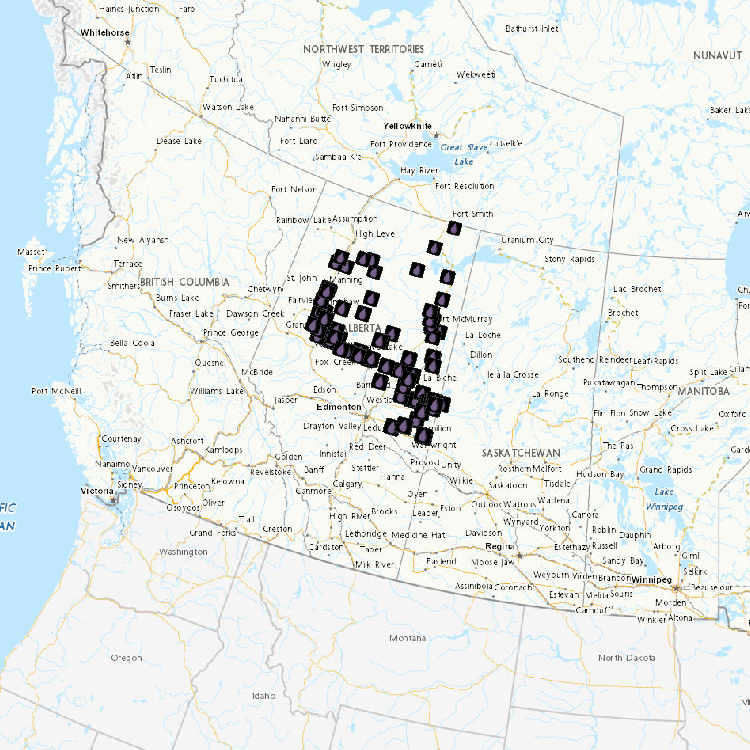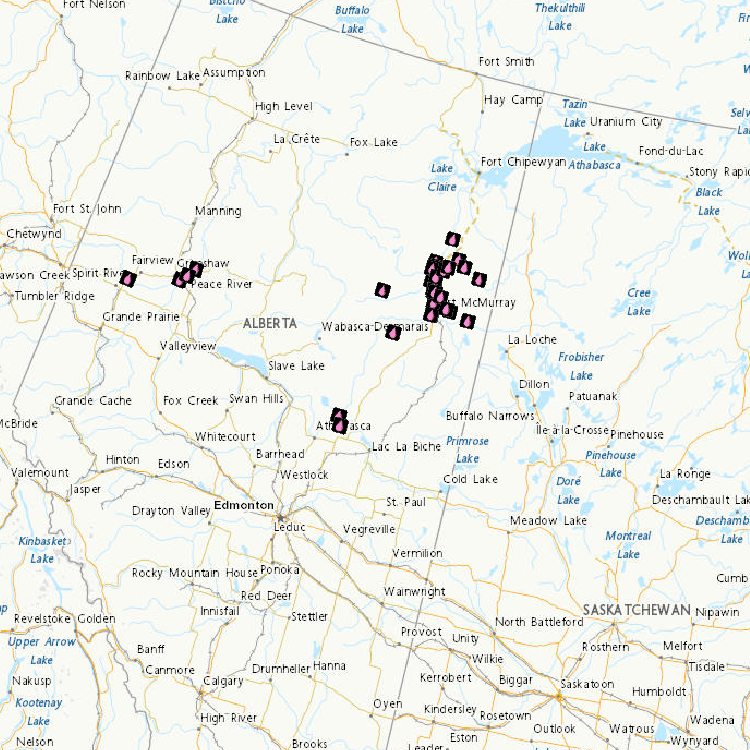Oil sands
Type of resources
Topics
Keywords
Contact for the resource
Provided by
Formats
Representation types
Update frequencies
status
-

The health of individual amphibians, amphibian populations, and their wetland habitats are monitored in the oil sands region and at reference locations. Contaminants assessments are done at all sites. Amphibians developing near oil sands activities may be exposed to concentrations of oil sands-related contaminants, through air emissions as well as water contamination. The focus of field investigations is to evaluate the health of wild amphibian populations at varying distances from oil sands operations. Wood frog (Lithobates sylvaticus) populations are being studied in Alberta, Saskatchewan and the Northwest Territories in order to examine the relationship of proximity to oil sands activities and to prevalence of infectious diseases, malformation rates, endocrine and stress responses, genotoxicity, and concentrations of heavy metals, naphthenic acids and polycyclic aromatic hydrocarbons.
-

Plant health assessments and vegetation surveys are undertaken at both terrestrial and wetland sites in the oil sands region and in reference areas. Plant monitoring is being conducted for biodiversity and contaminants, and because plants are important both as wildlife habitat and as traditional-use species. Plant and soil samples are collected at monitoring sites near and at varying distances from oil sands operations. Plant tissues are being examined for levels of naphthenic acids (NAs), polycyclic aromatic hydrocarbons (PAHs) and heavy metals. Plant indicator species include Vaccinium spp. (blueberry), Ledum groenlandicum (Labrador tea), Arctostaphyllos uva-ursi (common bearberry), and Cornus canadensis (bunchberry). Soil samples from riparian banks and boreal forest locations are also collected for greenhouse studies. These experiments evaluate the uptake, distribution, and toxicity of the contaminants in plant tissue.
-

The surface water quality (WQ) program, as part of the Joint Canada/Alberta Implementation Plan, is designed to improve the ability to detect change and predict effects in relation to point and non‐point sources. A mass‐balance approach has been used for assessing the quantity, movement, and cycling of materials in the watershed. Applying this approach required a sampling program which included quantification of the sources, transport, flux, and fate of materials and contaminants. The Surface WQ monitoring sampling includes, in part, collection of; - event (freshet and rain) based WQ samples in tributaries ranging from daily to bi-weekly, - WQ samples in the Athabasca River using cross-channel transect methods at specified Phase 1 sites, - enhanced (additional parameters) WQ sampling at M9, M12, and M11A and at 5 new interconnecting channel stations within the Expanded Geographical Area (EGA), - ground water samples in specific high priority tributaries, and - auto-monitoring (near real-time) on a subset of parameters at sites in the EGA
-

Water level and discharge data are available from Water Survey of Canada’s Hydrometric Network. The Water Survey of Canada (WSC) is the national authority responsible for the collection, interpretation and dissemination of standardized water resource data and information in Canada. In partnership with the provinces, territories and other agencies, WSC operates over 2500 active hydrometric gauges across the country, maintains an archive of historical information for over 7600 stations and provides access to near real-time (water level and stream flow) provisional data at over 1700 locations in Canada.
-

Tree swallow (Tachycineta bicolor) nest boxes are installed in oil sands area and in reference locations to monitor contaminant levels and impacts on tree swallow nestlings. The exposure to tree swallow nestlings to air-borne oil sands-related contaminants such as polycyclic aromatic hydrocarbons (PAHs) is assessed using passive air samplers. Measures of avian health are examined in relation to location of sampling and contaminants measured.
-

The objectives of the fish component of the integrated oil sands monitoring program are to provide the necessary data/information to address key questions related to both environmental health of fish populations and fish health issues that can be used to inform human use and consumption. The questions underlying the fish monitoring design are related to the status and health of wild fish populations in the Lower Athabasca River including and in an expanded geographical extent. Data is being collected to provide a baseline against which future changes in fish populations will be evaluated, and compared to data from historical studies to assess change over time to the current state. Data is also being collected in areas of new oil sands development, to develop baseline data for future site-specific comparisons, contribute to an expanded geographic basis of the overall monitoring plan, and contribute to an improved ability to examine cumulative effects.
-

Air emissions from oil sands development can come from a number of sources including industrial smokestacks, tailings ponds, transportation, and dust from mining operations. Air quality monitoring under the Joint Canada-Alberta Implementation Plan for the Oil Sands is designed to determine the contribution of emissions from oil sands activities to local and regional air quality and atmospheric deposition both now and in the future. Ambient air quality data include: - Filter Pack (24-hour integrated concentrations of particle-bound SO2-4, NO-3, Cl-, NH+4, Ca2+, Mg2+, Na+, K+ and gaseous SO2 and HNO3 collected daily by the Canadian Air and Precipitation Monitoring Network) - Total Gaseous Mercury (hourly mixing ratios measured by the Canadian Air and Precipitation Monitoring Network and Prairie and Northern Region) - Atmospheric speciated mercury (Hg) (2-hour average concentrations of gaseous elemental Hg (GEM), reactive gaseous Hg (RGM), and Hg on PM2.5 (total particulate Hg - TPM) - Comprehensive set of measurements collected from an aircraft (various time resolutions) covering an area of 140,000 km2 over the oil sands region - Comprehensive set of measurements collected from the Fort McKay Oski-ôtin monitoring site - Ozone (hourly mixing ratios measured by the Canadian Air and Precipitation Monitoring Network) - Ozone Vertical Profiles (ozone mixing ratios as a function of height) measured by the Canadian Ozone Sonde Network - Aerosol Optical Depth (measure of the degree to which the presence of aerosols in the atmosphere prevents the transmission of light, from the ground to the top of the atmosphere) measured as part of the AErosol RObotic CANadian (AEROCAN) network - Satellite overpass data have a relatively high spatial resolution over the Oil Sands region to produce images and geo-referenced data of nitrogen dioxide (NO2) and sulphur dioxide (SO2) “vertical column density” (which correlates with surface concentration)
-
Assess the importance of atmospheric deposition of contaminants as a contributor to ecological impacts of oil sands development and identify sources. • Use snowpack measurements sampled across a gridwork to develop maps of winter-time atmospheric contaminant loadings for the region ~100 km from the major upgrading facilities • Assess long-term trends in winter-time atmospheric deposition • Determine the potential impact of wintertime snowpack mercury loads on tributary river water mercury concentrations (Spring Freshet) using Geographic Information System and hydrological modelling approaches • Compare snowpack loadings to those obtained from precipitation monitoring and compare spatial patterns to PAC air measurements obtained from passive sampling network
-

Aquatic bird eggs are being collected for contaminants analysis. Egg collections in the Peace-Athabasca Delta area support Parks Canada’s activities at Wood Buffalo National Park and the multi-stakeholder Peace-Athabasca Ecosystem Monitoring Program. This monitoring activity employs repeated censuses of birds and builds on initial egg collections made in 2009 from Egg Island (Lake Athabasca) and Wood Buffalo National Park, with the goal of evaluating contaminant burdens, contaminant sources and changes in sources through time. Egg samples are collected from colonial waterbirds California Gulls (Larus californicus), Herring Gulls (Larus argentatus), Ring-billed Gulls (Larus delawarensis), Caspian Terns (Hydroprogne caspia) and Common Terns (Sterna hirundo) and insectivorous birds Bank Swallows (Riparia riparia), Cliff Swallows (Petrochelidon pyrrhonota) and Tree Swallows (Tachycineta bicolor) to monitor health and contaminant levels of aquatic and terrestrial birds in the oil sands region and in reference areas. The samples collected are analysed for oil sands-related contaminants including polycyclic aromatic hydrocarbons (PAHs) and metals such as mercury (Hg) and arsenic (As).
-

Benthic invertebrates monitoring includes both lotic (rivers/streams) and lentic (wetlands) ecosystems. Aquatic biomonitoring provides a direct measure of change in biotic populations and communities in relation to benchmark or reference conditions and can help identify the ecological effects of cumulative stressors. Used together with the water chemical and physical monitoring components, this program uses an integrated approach to assess whether ecological affects are occurring in response to OS developments. Sampling can include the collection of invertebrates, algal biomass, water chemistry, and appropriate supporting habitat information and is conducted during periods of high abundance and diversity of macroinvertebrates. Sampling focuses on near-shore gravel and sand habitats on the Athabasca River, erosional habitats on major tributaries and in wadable areas in deltaic wetlands within the Expanded Geographical Area. As of October 2012, over 80 locations have been visited.
 Arctic SDI catalogue
Arctic SDI catalogue